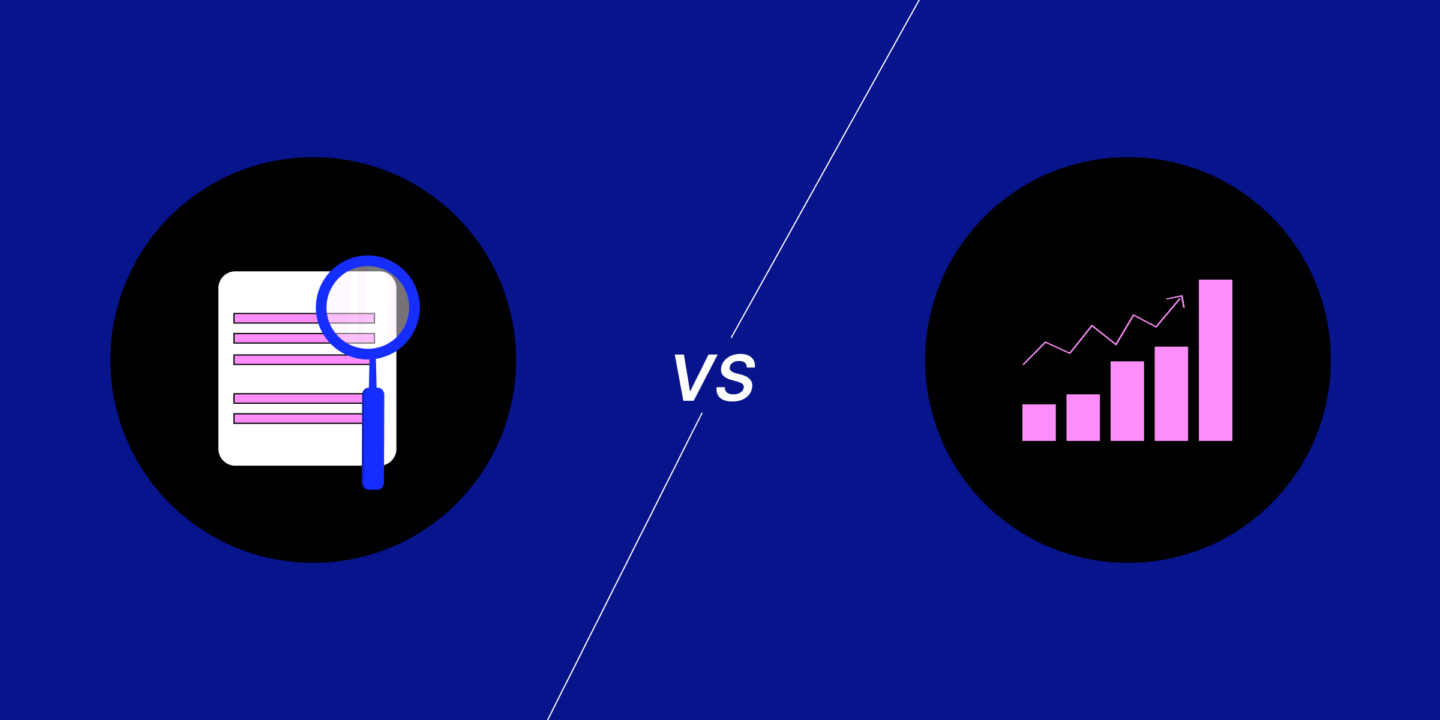
Fundamental analysis vs. technical analysis. Which one is better?
Well, it’s an age-old question with no concrete answer. It’s because both methods serve different purposes to different people. They are two major schools of thought at opposite ends of the spectrum. Both have their place in the market. Hence, we need to reframe the question to ‘which one suits you?’
Lucky for you. We are here to explain the basics and the critical differences between them so you can decide for yourself.
But before jumping into the topic, we hope cryptocurrency is part of your investment strategy; if not, check out Mudrex Coin Sets. It is a theme-based crypto fund for long-term investors to build wealth. You should give it a shot.
What Is Fundamental Analysis?
Have you ever reviewed a company’s financial statement, the market where it operates, or the macroeconomic factors?
If yes, then congratulations. You have performed a fundamental analysis.
Fundamental analysis examines all the quantitative and qualitative factors that can influence the share price of a stock. It includes macroeconomic, industry-related, and company-specific factors.
The end goal is to identify the intrinsic value of a share, which might not equate to its current market price. Fundamental analysis relies on the hypothesis that markets are not perfect. There is an inherent delay in influencing the share prices through these factors. Hence, the market price and intrinsic value don’t match in the short term, but in the long run, it adjusts itself.
Moreover, the share’s intrinsic value can help to figure out its future value.
Fundamental analysis can be done in crypto too. However, the approach followed with cryptocurrencies is slightly different because of the lack of public financial statements and other factors. Instead, we consider blockchain data to analyze the strength of a crypto project. It takes into consideration data like Network Value to Transaction Ratio (NVT), Market Value to Realized Value Ratio (MVRV), and more. Here’s a detailed blog on crypto fundamental analysis.
Long-term investors prefer fundamental analysis. They try to find out the intrinsic value of an asset before investing in it. It helps them buy when the value is less than the market price.
What Is Technical Analysis?
Technical analysis helps to forecast the future market price of an asset based on its past performance.
While fundamental analysis requires reviewing financial statements, industry data, and economic reports, technical analysis is done differently. It involves the usage of price charts and indicators to find where to buy and where to sell the asset. These indicators include support and resistance lines, moving averages, trend lines, etc.
Technical analysis believes that markets in the short term are heavily influenced by human emotions like fear and greed. And since humans tend to always react the same way when put in similar situations, over time, patterns get built in the way assets are traded. Technical analysis is the study of those patterns to make trade decisions. Unlike fundamental analysis, it believes that all the crucial factors are already factored into an asset’s current price.
Traders and speculators use technical analysis for swing training and short-term investments. You can read about charts and technical indicators used in the crypto market in our blog.
Fundamental Analysis Vs. Technical Analysis: Key Differences
Fundamental analysis assumes that the current market price of a share doesn’t tell the complete picture. Hence, it reviews the past and present data to determine the share’s intrinsic value. In comparison, technical analysis assumes that all the crucial elements are already factored into the asset price. Hence, it relies only on past performance to make future predictions.
| Parameters | Fundamental Analysis | Technical Analysis |
| Year of Origin | 1934 | 18th Century |
| Goal | To determine the intrinsic value of stocks | To predict the near-term price of an asset |
| Timeframe | For long-term investments | For short-term investments |
| Audience | Long-term Investors | Swing traders and short-term traders |
| Data timeline | Uses past and present data | Uses past data only |
| Data Source | Financial statements, industry reports, economic reports, and news events | Price charts with patterns and indicators |
| Application | Mostly used for stocks and also works on cryptos | All asset classes |
What Are the Tools Used for Fundamental Analysis?
You need three critical tools to perform fundamental analysis.
1. Macroeconomic analysis
A company’s growth potential depends on the country or the economy in which it operates. The state of the economy can be assessed using parameters like the unemployment rate, inflation, GDP, disposable income, etc.
Note: A fast-growing economy with encouraging policies and a young talent pool is favorable for businesses.
2. Industry analysis
Industry analysis is an assessment tool to understand a sector’s future potential. Below are the methods used to perform the industry analysis.
- Porter’s five forces: It helps understand the intensity of competition within an industry.
- SWOT analysis: It summarizes the strengths, weaknesses, opportunities, and threats of an industry.
- PEST analysis: It assesses Political, Economic, Socio-demographic, and Technological factors that can influence an industry.
- Competitive benchmarking: It compares the top players across parameters within an industry.
- Industry Lifecycle analysis: The lifecycle of an industry consists of four stages – Entry, Growth, Maturity, and Decline. This tool helps to identify the current stage of the sector.
Note: Having a good market share in a growth sector is better than being a top player in a dying one.
3. Company analysis
Company analysis involves reviewing a firm’s financial and non-financial characteristics. The financial aspects of a company can be assessed through its financial statement. It covers the income statement, cash flow statement, and balance sheet. Non-financial components include the business model, competitive advantage, management, corporate governance, etc.
Note: Most of the time, investors focus too much on financial metrics and leave behind non-financial ones. But numbers can be deceptive. Hence, giving equal weightage to both of them is essential.
Fundamental analysis applies to cryptocurrencies as well. Crypto fundamental analysis uses metrics like utility, audience, competition, user demand, liquidity, etc., to determine the true value of a crypto project.
What Are the Tools Used for Technical Analysis?
For technical analysis, five different tools are available to make price forecasts.
1. Trend lines
Trend lines are drawn on a price chart to show that the asset price is following a specific direction. Traders use it to identify entry and exit positions to maximize gains.
2. Support and resistance level
Support and resistance levels are minimum and maximum ranges between which the price of an asset navigates. It is formed based on the historic movement. Traders enter or exit the market if the price moves beyond the support or resistance level.
3. Moving averages
Moving Averages are lines formed by calculating the average price of an asset across a specific timeframe — daily, weekly, or more. It helps to identify potential trend reversal.
4. Trading volume
Trading volume indicates the level of activity in a market. High trading volume means more people buy and sell a particular asset or vice versa. Volume plays an important role in determining an asset’s liquidity.
5. Patterns and indicators
Several chart patterns and indicators help traders to determine future price movements. Some examples are On-Balance Volume, Bollinger Bands, MACD, and Relative Strength Index.
One can also use these technical analysis tools for predicting crypto price movements. But please keep in mind that these are general guidelines. There is no set rule for the markets to stick to these patterns.
Conclusion
We can’t say that fundamental analysis is better than technical analysis or vice versa.
Investors typically use fundamental analysis to deploy their capital for a longer duration. But technical analysis is used by traders to make quick returns, and the funds are deployed for a short period.
Hence, one must select the appropriate tool based on their goals and investment timeframe.
FAQ
1. Is fundamental analysis more accurate than technical?
It’s difficult to say one is better or more accurate than the other. Fundamental analysis is more suitable for making long-term investments. But technical analysis is used for short-term trading. Some experts advocate using both methods together.
2. Which indicator is best for fundamental analysis?
The following quantitative indicators come in handy while performing fundamental analysis.
- Earnings per Share (EPS)
- Price to Earnings ratio (P/E)
- Price to Book ratio (P/B)
- Price to Sales ratio (P/S)
- Return on Equity (RoE)
- Debt to Equity ratio (D/E)
- Projected Earnings Growth (PEG)
- Free Cash Flow (FCF)
- Unemployment Rate
- Gross Domestic Product (GDP)
- Inflation Rate
For cryptos specifically, indicators like Network Value to Transaction Ratio (NVT) and Market Value to Realized Value Ratio (MVRV) come in handy.
3. What time period is best for technical analysis?
It’s difficult to pinpoint one specific timeframe for performing technical analysis. It depends on the individual’s trading style. The timeframe on price charts ranges from one minute to even a yearly period. 5-minute and 15-minute charts help execute daily trades. Other popular periods include hourly, 4-hour, and daily.





